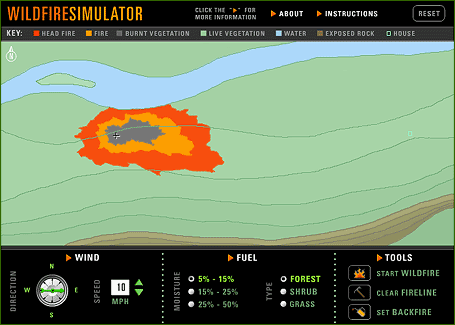

|
|
|

|
Description of "Wildfire Simulator" 
Introduction | Wind | Fuel | Start a Wildfire | Clear a Fireline | Set a Backfire | About Wildfire Simulator is a fire-growth computer model that has two purposes: First, to let users see how certain conditions, such as wind speed and direction, affect the spread of a wildland fire. Second, to show how to use a fireline—alone or in conjunction with a backfire—to control a fire. (A fireline is a path along which fuel has been removed, and a backfire is a fire purposely set to burn away fuel.) To begin, a user sets the wind and fuel conditions. He or she then uses the "fire" icon to start a fire. If the user decides to fight the fire, his or her goal is to stop the fire from reaching the house. To stop the fire, the user can create a fireline with the tool that looks like a pick and widen the fireline by creating a backfire with the drip torch. Weather is the most variable of the conditions used in predicting fire behavior. Wind in particular has a great impact on where and how fast a fire travels. In addition to moving horizontally, wind can flow vertically, forming updrafts and downdrafts. Also, heat from a fire can generate its own winds, when hot air above the fire rises and cooler air rushes in. Complicating fire prediction even further, fingers of wind often funnel up a ravine or are diverted in other ways by topography, changing their direction relative to the general wind direction. This model lets users control wind speed and horizontal direction. Back to top In a wildland fire, anything that can burn is considered fuel. This includes leaf litter and fallen dead branches as well as live vegetation such as trees. In deciding what to do in this fire simulation, you have to consider how easily a fuel can burn. This is determined by the amount of moisture the fuel contains, which depends on whether the fuel is living, dormant, or dead. The moisture in the fuel also depends on the moisture content of the surrounding air. Moisture content of air is often expressed as relative humidity. In this model, users select "fuel moisture content." Fuel moisture content is a measurement of the amount of water in a fuel compared to the weight of the fuel when it is dry. Back to top Every year in the U.S., humans cause an average 103,000 wildland fires, resulting in the burning of almost two million acres. These fires are started intentionally and by accident—by foresters, farmers, and arsonists, and by careless campers, hikers, and cigarette smokers. Lightning strikes, on the other hand, cause fewer fires—an average 14,000 a year—but these fires consume over 2.1 million acres.* To start a fire, users click the "fire" icon, position the cursor anywhere on the map, then click again. Back to top One of the most important techniques used in fighting wildland fires is the fireline. A fireline is a path that firefighters create by chopping and scraping away all fuels, leaving only bare soil and rock. When a fire reaches the path, the lack of fuel should cause the fire to go out. Construction of a fireline begins at an anchor point—a rock or stump or some other landmark. From this point, the firefighters cut a line around the edge of the fire. Often this is done by hand, using chain saws, shovels, rakes, and Pulaskis (a combination ax and hoe that is unique to wildland firefighting). If the landscape allows, bulldozers can be used, too. To save on resources, a fireline should be no wider than necessary—usually three to six feet wide. Users create a fireline by clicking the Pulaski icon, selecting the location on the landscape, then clicking again. Back to top A backfire is used to widen a fireline by burning away the fuel that lies between the fireline and the wildfire. Backfires are lit along firelines as well as along existing firebreaks, such as roads and streams. The drip torch is one of the tools firefighters use to intentionally set a fire. Other fire-starting tools include fusees, which resemble flares, and flame-throwers. These are used for both backfires and to set prescribed fires, a kind of controlled burning that reduces the amount of fuel in an area. Backfires are lit by dragging the drip torch to a place on the map between a fireline and the wildfire, then letting go of the mouse button. Back to top Wildfire Simulator is a simple computer simulation that predicts the behavior of fire in a wildland environment. Programming for this feature is derived from FARSITE, a professional fire-modeling application. Wildfire Simulator is not designed to be used as a tool to predict the spread of actual fires and should not be used in this way. For more about FARSITE, BEHAVE, and other software applications relating to the spread of wildland fires, visit http://fire.org. * These figures are yearly averages, 1988 - 1997. Sources: U.S. Fire Administration and National Interagency Fire Center.
The Producer's Story | The World on Fire | Outfitting Wildland Firefighters How Plants Use Fire | Glossary of Fire Terms | Wildfire Simulator | On Fire Resources | Transcript | Site Map | Fire Wars Home Search | Site Map | Previously Featured | Schedule | Feedback | Teachers | Shop Join Us/E-Mail | About NOVA | Editor's Picks | Watch NOVAs Online | To Print PBS Online | NOVA Online | WGBH © | Updated June 2002 |